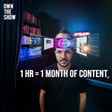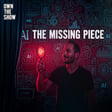Introduction to AI Micro Skills Podcast
00:00:00
Speaker
Welcome back to AI Micro Skills, where I'm helping marketers master AI to do more, do better, and overcome the overwhelm, since we all have too much to do as marketers, it seems.
Guest Introduction: Bart Kahler
00:00:11
Speaker
I'm here with Bart Kahler from Kahler Solutions, a friend I've known for a couple of years now.
00:00:16
Speaker
we've done a lot together in different marketing circles, especially around higher ed.
AI in Visual Applications
00:00:21
Speaker
But I've been so excited because you've really been pushing the envelope when it comes to AI, especially around what you can do visually with AI. Because lots of people are talking about chat GPT, including me, like I've been posting lots of different stuff, custom GPTs, the forks, and
00:00:37
Speaker
I've only just this week started really pushing the visual stuff.
AI's Role in Marketing and Creative Fields
00:00:41
Speaker
And you've been doing it for doing it for a few months now. I've been seeing you post videos about like, talking head videos that have perfect travel. Well, not perfect, but like pretty dang close to perfect translation. Yeah, mouth is all moving, right? And I'm like, so you I've seen you've been posting about this stuff for months and months and months now. So you're way ahead of us on a lot of this stuff. And I wanted to
00:01:01
Speaker
like explore this topic of where AI is at and being able to assist marketers in photography, in design, maybe in video
AI vs. Traditional Design Tools
00:01:10
Speaker
too. What are you finding is practical right now for marketers? Where are you using it? So there's a ton of places that's right now. And I guess before I even start getting into those micro skills and some of the things that I'm doing with it, the use cases,
00:01:22
Speaker
I always like to start off and just say, look, AI is not going to take your job. It's going to be one of those things that it is another tool. I started my career in 1992 and when I got my first design job, they were just plopping the Big Macs down on the desks and saying, okay,
00:01:39
Speaker
designers, art directors, creative directors, figure it out because this is the way we're doing it now. And I knew how to do it. And so I was able to kind of jumpstart my career because I had some skills and some tools that everybody else around me didn't. And so I think if you're a designer or any kind of creative that's listening right now, take stock in that and realize the fact that you're even listening to this podcast, you are gonna be in high demand. So your job's not gonna go away.
Bart's Career Journey
00:02:06
Speaker
And so I really think that that's one thing to keep in mind is that this is another tool in your tool bag. Right now you might be using Photoshop or Illustrator or Canva. This is just another another set of tools that you can use. And so practically for me to answer your question, you know, I use you started your career as a designer.
00:02:25
Speaker
Yes, I did. I thought you started as like a web code guy or just a marketer, but you started in design. I was a graphic design major and it was in 1992 when I graduated, the web hadn't come out yet. And so it was literally print design is what I started out in. And I happened to have had a propensity toward the Mac. And so during college, I was playing on those little square Macs, you know, and we had Photoshop and
00:02:51
Speaker
Yeah, page maker, the very, very earliest versions of stuff. And so when I started all that, you know, I remember in 1994, my wife was doing her graduate work at Wright State University in Dayton, and I would go in the evenings while she studied and I would they had their card catalog hooked up to the internet.
00:03:07
Speaker
And so that's when I first started surfing and seeing what things were about. And I went back to my boss the next day and I said, hey, I think this whole internet thing might be something that marketers and designers like us should be doing.
Excitement about AI's Potential
00:03:20
Speaker
And I think it's going to do something. And he assured me it was a fad that I didn't need to worry about. But then being the entrepreneur that he was, he went out and sold a website when he had a chance. And I said, I didn't want to do one. I thought we had to look into it. He's like, well, now's the opportunity. And I get a chance to do it.
00:03:35
Speaker
That's exactly right. So that's kind of the way we're doing it now with AI. It's I was telling somebody the other day. I've never felt the same feelings that I am feeling. You know this past 12 months as then when I was back in 1994 doing my first website, you know, looking at source code, figuring out how did they do that in HTML and how can I copy that and do it on my sites?
Generative AI Tools in Use
00:04:00
Speaker
I mean prompts are out there. You can copy and paste prompts from mid journey or.
00:04:05
Speaker
chat, GPT, wherever you're at, there's a ton of people that are out there willing to share what they're doing. You just have to be kind of intentional to go find it. And so some of the things I'm doing, I mean, obviously I've been using chat a lot. I use Claude AI a lot and perplexity. Those are probably my three that I go to most for kind of that chat conversational generative AI. And then as far as visuals, I've played with the Dolly within chat. It's a lot better in the four version, the paid version.
00:04:35
Speaker
So I'm using that. I'm using mid-journey a lot. I really kind of started using mid-journey probably January of last year because I saw that from what I could read, it was kind of out there further than anybody else. And then since then, obviously Adobe has done a ton in there. They've invested a lot of money and you can see that in their Photoshop.
00:04:56
Speaker
It's pretty incredible. So I've played with that, but I would say right now I'm spending the majority of my time in Claude chat and mid journey. And just to kind of give you a sample of the things that I'm typing, trying to do, I, I'm doing a lot more speaking now because of, you know, getting into AI and in higher ed, you know, they like to have you come and talk about those things. And plus I just wrote a book. And so I've got all these different things that I'm doing and, and practical uses that I'm using it for is.
00:05:22
Speaker
So I've got a presentation that I've got to give at ABHE. You and I have done that together. And I'm going to be down there in February in Orlando. And I needed to do a presentation to presidents about the myths and truths of higher education marketing.
AI in Presentation Design
00:05:36
Speaker
And so I had agreed to do this probably eight months ago. David Metters, who you and I both know, he kind of wrote this really slick little, you know, what people would learn from it. And so I took that, what he wrote. I threw it into chat.
00:05:49
Speaker
And then I said, Okay, I just wrote my book. So I threw my book into chat the PDF of my book. And I said, I want you to take ideas out of my book and match it to this and give me an outline for a 60 minute presentation. And so it generated
00:06:05
Speaker
It generated the presentation out of what the abstract was for the talk out of all the content that I had for the book. And so that gave me my draft of the 12, 18 slides that it was going to have me do. And then what I did is I said, okay, now that you've had that, now I want you to take each of those slides and I want you to develop a myth
00:06:27
Speaker
And give me a headline for the myth and give me a truth and give me a headline for the truth. And then I want to have a slide. The next slide is going to be key findings and give me three bullet points out of my book and give me the page number that you referenced it from. So I had to use Claude for that to get a little bit more advanced. And so
00:06:45
Speaker
It generated that out and so now all of a sudden I had a script for exactly what I was going to take into Canva. I had bullet points with page numbers and it was referencing from my book so that I could and I put those in the notes because I didn't want to have page numbers on my slides.
Creating Emotionally Resonant Visuals
00:07:00
Speaker
And so then the next thing I did is I said, OK, now I want to have visuals for all of this. And so I've been going really deep in mid journey and a couple of guys that I've been following. Let me see what his name is. It's Rory. You might know who he is right off the top.
00:07:15
Speaker
I can get it for your show notes, but his, he, he is a kind of a leading ad agency guy that's using mid journey. They're using mid journey for all of their paid ads, their, their digital advertising firm. And he's going deep into mid journey. So they're generating anywhere between
00:07:32
Speaker
20,000 images a month for all of their clients using Mid-Journey. In this talk that I watched, he basically explained how to do the essence of a prompt to make it really successful in Mid-Journey. He did this presentation back in December. Well, since then, Mid-Journey 6 has come out, which is blowing the doors off of everything right now.
00:07:54
Speaker
And so what I did is I went into chat GPT and wrote a custom GPT utilizing his script for how to do a good mid journey prompt. You know, he knows all those little, you know, style equals raw and AR equals 16 nine. I don't understand what all that stuff is, but you know, he outlined what that was and the best numbers to get the certain kind of like hyper realistic results or other things. Yeah.
00:08:18
Speaker
So I created this custom GPT that would allow me just to go back and answer questions. And so it prompts you to say, Hey, what's your subject? What kind of mood do you want to set? What's the lighting like? And so I just answered like five or six questions. I added some additional custom things in there for like, because I'm higher ed, it's like, what campus do you want to reflect? You know, what do you want it to be? And I found that that's been really helpful for me to kind of generate a nice mid journey prompt that I can then copy and paste out of
00:08:45
Speaker
out of the chat GPT and the mid journey. And I can get some pretty impressive stuff pretty quick. And so I use that for this presentation where I wanted to kind of show off, you know, these, these different emotional settings in the presentation where, Hey, here was the, I didn't even notice they were, I thought they were all photos. They were looking through your presentation. I came to the end. They're like, Oh, by the way, do you notice these were all AI? I'm like, where are they? I'm flipping back. I'm like,
00:09:12
Speaker
Huh. You look real to me. And I intentionally designed it because I wanted the myth to look like it was coming from a desperate board of higher education who were downtrodden. So I wrote all this prompt about make them downtrodden, make them, you know, make it chaotic. And so I turned all those into black and white photos that were very, it stirred emotion in my viewer so that when I was saying, hey, this is the myth, you're probably hearing this from your board.
00:09:38
Speaker
You're, you're getting a lot of, you know, it's causing you angst. And then when I showed the truth, I had these gorgeous shots of campus shots at golden hour and happy, happy Generation Z students and, and the hopefulness of all of this. That was all intentional because I, in my presentation, I wanted to make sure that I communicated that I would have never been able to pull that off with stock. Or if I would, it would have taken forever to find the right stock image.
00:10:04
Speaker
Yeah, the right, you know, I might have found one, but hey, I really need to have 10 board members because I've got 10 myths.
AI's Role in Client Projects
00:10:11
Speaker
So utilizing mid journey to do that gave me a tremendous opportunity. And then as I'm looking through it, I'm like, Okay, I'm, I'm missing, you know, a racial representation or ethnic representation, I could go back into my prompt and say, you know, make it a 55 year old
00:10:28
Speaker
female Hispanic. And then all of a sudden, I've got somebody that is going to fit that profile to fit in what I wanted that kind of gave the feel of everything else. And so that's a very practical way that I've been using some of this. And that's just an example for a presentation that I'm doing. But I have not yet used it. Right now, I'm using it for presentations. I'm using visuals for social media, for
00:10:52
Speaker
for some of my own things. But I haven't used the visuals yet for any clients. I've been talking to them about what I'm calling not so stock stock imagery. And I know that there are some schools that are starting to lean into utilizing visuals. They're trying to do it in such a way to be able to say this was created with the help of Mid-Journey. So they're acknowledging the fact that they used AI and the creation of the visual. And some of them are even calling them that these are aspirational images of our campus.
00:11:22
Speaker
These are aspirational images of our students. So they're getting around that because there's still a lot of debate on where does mid journey get the images and how is it learning? And there's a lot of misunderstanding about how these large language models are trained. They think it's like Google search where if you go to Google images, you see a ton of images. Well, that's not what AI is doing. It's basically
00:11:49
Speaker
learning like we learn as humans and you give it enough Generation Z students and then you ask it to put a Generation Z student somewhere. It's like, oh, I know what a Generation Z student is. It's this and this. I can create that because I know it. So it's not like you're actually, it's not stealing images and repurposing it. It's actually learning what that image is supposed to be and then giving you that.
00:12:14
Speaker
That's why you get weird things sometimes. I mean, it's one thing you got to count all the count all the fingers before you put it on to something.
AI Instructions and Interaction
00:12:20
Speaker
True. I get to come back a little bit. So we've covered a lot of ground here. I want to come back presentation you first made because there's so much to cover here. I'm sure there's many people that have gone to something like chat GPT and just been like, write me a presentation on X. And they don't get great results. But what I saw you do is break it down into multiple steps. One, you had context for it to start from. You had a whole book of content.
00:12:43
Speaker
And you had the context of the introduction of the description of the talk written for you, right? And the title. And then you gave it a good prompt.
00:12:54
Speaker
to set the tone, you also gave a direction where you structured it based on your based on this content, create you, you essentially told it what direction to go into. And I think that's where a lot of people are missing it with AI in general, is that you can't just ask it for something, you have to have a really clear idea of what you want. It's like, it's like you almost have to think about it as delegating to an intern that it's extremely
00:13:18
Speaker
knowledgeable, but very lacks common sense. This is the I this is where the picture I have in my mind of AI right now, because I used to work with interns all the time 18 year olds very willing, very willing, lots of heart.
00:13:30
Speaker
doesn't, but they didn't know anything. So I had to train them on how to do it. And I had to bake everything into step by step instructions, because they'd wander, right? And they'd, they'd get stuck more often and be like, I don't know what to do. But like, dude, did you follow the list, right? Exactly. Step by step. So if you if you do that for AI, look, AI is very competent, and it wants to do it. And it will do something, it might not do the right thing. But yeah, give it context and step by step instructions, it will execute an amazing amount of work for you.
00:13:56
Speaker
I think you're exactly right. And I know that Dr. Jules White, he has a couple of different courses on Corsilla and he's a professor at Vanderbilt University. And I've taken several of those. He uses that intern as an example. And I love that because I think that you're right. You wouldn't fire an intern when they came back and gave you something that you weren't expecting. I mean, we've all had interns and you'd be like, no, this isn't right. You would not say, I'm never using you again, get out of my face.
00:14:22
Speaker
That's what a lot of people do with AI. The first time they try it, they're like, this isn't anything big a deal. What's the big deal? And they close it down. That's the biggest mistake you can make. You have to look at it like that conversation. Like you said, give it context, give it step by step instructions, but then say, hey, do you have any questions for me? And then chat GPT will come back and say, yeah, here's 16 questions that if you can answer these, it'll help me give you a better answer. That's one of the keys is having, recognizing it's a conversation
00:14:50
Speaker
to have with them, as opposed to just this idea of, oh, I just expect it to go and create some magic box.
Streamlining Design with AI
00:14:56
Speaker
But I think you're exactly right, Dan. You've got to think about it from a contextual, very step-by-step instructions, and have a conversation with it.
00:15:04
Speaker
One of the things you brought up was that I think this is the big realization I've had over the last week that it's not going to replace designers. But do you remember like a lot of time is spent in graphic design since we're speaking to marketers, you probably weren't a designer. Most time designing is actually not designing. It's actually looking for the thing that you can help then design. Yeah, it's inspiration. Graphic designers are just manipulators, but we need very few designers can create raw
00:15:34
Speaker
Stuff for them to manipulate like very few designers are also photographers now There's many photographer designers, but even less illustrators
00:15:45
Speaker
or people who come up with custom typefaces. Graphic designers usually don't do those things, but they have to use all those things in order to come up with work. Now, they can make custom logos and stuff. They know how to make some stuff, but oftentimes as a designer, you're spending probably 50% of your time. That's a lot. 50% of your time looking for that stock photo. Yeah, exactly. It's so infuriating.
00:16:10
Speaker
Nowadays it's a lot easier with unsplash there's so many there's such a wealth of free stock or cheap stock stuff out there i remember when i started in two thousand. Six two thousand five two thousand sixty two thousand eight was when i started as a designer you were just staring at an empty page in photoshop can you hardly had any photos to manipulate or good wants to work with her.
00:16:32
Speaker
Anything. Yeah. I remember back in the day when I started my career, we had a wall on the back of the studio that was just book after book after book. And so the stock agencies would send out huge, you know, phone book. I mean, even some of the people listening now don't know what a phone book is. They would send out these huge books, hardbound books of photography, you know, and all the photographers would buy a spread to show off their work. And you would go back there and flip through those for hours just to kind of get an idea of, oh, that's kind of the feeling I have in mind.
00:17:02
Speaker
that photograph, then you would either hire that photographer to come and do it, or you would get us tear sheets and put together a mood board and take it to a local photographer to say, this is kind of the field that I'm thinking and you might have a sketch. So I mean, it would be thousands and thousands of dollars to get a photo that you have in your mind to get on the cover of a brochure. And it's not that way anymore.
00:17:24
Speaker
Yeah, and it's like, and all these tools is as good as Photoshop, I mean, Illustrator and all these tools and all the stock stuff now, there's still plenty of designers, it's just sped up work and made exactly better.
Complex Illustrations with AI
00:17:37
Speaker
And I'm now seeing AI for what it actually is and just making work better because I don't have to spend time finding the perfect stock photo, I can just tell AI what I need.
00:17:46
Speaker
Exactly. And it just saves so much time. And illustrations, I actually like painting and drawing, but the time it takes to create a good illustration is intense, which is why most graphic designers use photography, because illustration is so hard to do. But now, man, even for this show, I'm creating collage-style, vintage collage-style illustrations, because I actually like that, and I don't know why. I'm just geeking out over that.
00:18:13
Speaker
But this show is going to be very vintage collage oriented now because that's the style I picked for it. But now I can do it because it was hard to get those things before. Hard to find vintage photos period, let alone cut them out and place them next to each other in a way that was visually interesting and stunning. Now it's fast. It is. And one of the things that I love about the people that are creating Mid-Journey, and you might not be aware of this, but Brian Piper kind of turned me onto this. Mid-Journey actually has their own magazine.
00:18:42
Speaker
It's a print magazine that comes out once a month and you can subscribe to it. And they just have the best of the work that's been done on mid-journey. And not only do they have the name of the person, but they have the prompt in there. So you can actually go in and see, okay, how did they do that retro photo look? How did they do that jewelry piece? And you can actually grab the prompt and put it in and adjust it how you need it and see if you can get something.
00:19:11
Speaker
I love that because it becomes very collaborative. I'd say if you're a graphic designer, have a visual background, you have an advantage because you have vocabulary for how to describe the thing you want. I know if I want something that's a vintage collage, there's a number of different words I can go to like collage or like dada as an art period where collage kind of got invented, right?
00:19:30
Speaker
Like there's enough or there's a number of I've just read enough books about graphic design and design history and art history to be able to draw from. But it's only a little bit of an advantage, because honestly, you can just go through the Mid-Journey Library, which I love when you log into it, it gives you a wall of all the stuff recently.
Ethical and Copyright Challenges
00:19:47
Speaker
You can just go perusing and click on one that you kind of like and you think is close to what you'd like and just find the prompt and bam, you have the language. Yeah, it's it is amazing. And that it also introduces the challenges because as you go into mid journey, you have to recognize that anybody can do the same thing else with what you're doing. So there's not a lot of, there's not a lot of guardrails right now as far as there is no way to copyright a mid journey image.
00:20:10
Speaker
at the current time as January of 2024. And there's still a lot of misconceptions and some taboos even around the images themselves because of the way they're trained. So I think all of that is something to at least be aware of.
00:20:28
Speaker
It's interesting you talk about the ethical problems of photos. I wish I would have had this available back when I worked at Bethany Global University, that missionary college, because I had stock photo problems, because I couldn't use photos of... It was a missionary training college for those
00:20:45
Speaker
You don't know and missionary training for missionaries and marketing it as a problematic because of some Christian some countries They'll kill you for doing that. Yeah, exactly. They'll literally kill you. So it's like super dangerous But you need photography in order to market it you're just kind of like it's it's kind of a weird thing I'm like, I would have used it all day and been like, yes, I don't have to use pictures of the real people But you can get the same feeling concerns would have been like annihilated from this. Yeah
00:21:11
Speaker
for that particular case that's kind of a random use case but but i think it could be safer for the institution and the students period even if there's not like a really extreme like danger case like there was with bgu
00:21:25
Speaker
I'd imagine it actually would be better for colleges to use fake students rather than real students, because then you don't have any of the legal problems of using real students. I think you're right. And I think that that's one of the things that you can do with Mid-Journey and all these tools. I keep using Mid-Journey, but that's kind of my catch-all for visual generative AI. But I think that one thing I have found is even just by putting the name of the institution that I want to represent, AI understands the world.
00:21:52
Speaker
And so when I put in my alma mater Anderson University and kind of say, you know, set the stock photo on Anderson University's campus, and I'm using a short depth of field so it's kind of blurry in the background, it knows enough that it's red bricks and white trim.
00:22:09
Speaker
And I can kind of fake it a little bit to say, okay, yeah, that sells
Advancements in AI Realism
00:22:13
Speaker
me on that. I did another one for Ball State University, which is an older school and it's more gothic. It had that feel in the photography. So it's not perfect. And you could never say, you know, you couldn't pass it for that. But when you're doing something that you're trying to focus on the students or focus on a vibe, this is a good way to kind of be able to at least get into the right setting. Like until recently, like AI photos had a look and feel to them.
00:22:39
Speaker
They were rubbery. They looked, they looked too good. But just recently, tell me a little bit about what you're seeing with mid journey version six and how that's, I don't know, changed things for you. Well, I think that it's changing the game in a lot of different ways because it's, it's more the photos look like photos that we would take. I mean, it's not, you mentioned it's, it's not that plasticky looking people or, or too perfect. It's, it, it kind of bakes in a whole lot more of what I would call real life into it.
00:23:07
Speaker
And so it's, it's, uh, and, and plus I think as you kind of look at it from what I've read is that the prior versions of mid journey kind of were based on everything was kind of centered or, or it would be kind of predictable and mid journey six is kind of introduced this, this, um, algorithm that kind of changes things up a little bit. And so even in my prompts, I like to even use like leading lines or.
00:23:32
Speaker
You know, the rules of third kind of to give a composition type of things mid journey is doing a lot of that more naturally in the, in the way it's delivering it in version six. But I think that now that you even can start to say those things of, you know, give me a composition with leading lines, it knows how to do that. And it will actually interpret that language, as you mentioned earlier, that design language and give you a lot better control on the way that you want to do those prompts. And so I have found that six is kind of like a game changer.
00:24:01
Speaker
In my presentations, I even have four slides of the same prompt that I did in January of last year, then I did it in March, and then I did it in December, and then I did it in January. It's just the amazing amount of vast differences just with one single prompt in four or five different versions of Mid-Journey. I've noticed a lot of people struggle with Mid-Journey. They get in there, they type out a prompt, and they're like, Dolly's about the same.
00:24:29
Speaker
What do you think the difference is between these two? When do you use one or when do you use the other? I have found that I like to use, I think that Dolly does a better job with just graphics and it does a pretty decent job with text.
00:24:45
Speaker
Mid-Journey 6 though is really amped the game up with text. You can actually say, have a sweatshirt that says this on it, and it generates a sweatshirt with that on it. But you kind of have to kind of play with both. I find myself especially like doing something in Mid-Journey, if I like to say I'm doing a t-shirt with words on it, I might then take it into Dolly or take it into Photoshop and just have Photoshop redo it or figure out some of the new tools with Photoshop and kind of create what I want in that environment.
00:25:14
Speaker
So i think you still you don't have one source of truth i mean you can't go to one tool and just say that's the tool i have i mean it's a suite of tools and being able to understand hey med journey does hyper realistic photographs really really well and it understands a lot better on some of the nuances of illustration.
00:25:36
Speaker
Dolly probably does graphic design better. If I needed to get an icon or if I needed to get something that was more specific to a piece of art that I need, a line drawing, Dolly does a better job with that. And so just being able to play with it and understand the tools that you have at your disposal, I think is going to make you a better designer, marketer, prompt engineer.
Integrating Multiple AI Tools
00:26:00
Speaker
because that's, that's, I mean, no one knows. I mean, no one can use just chat GPT. You've got to, you've got to understand all the tools that are out there so that you can do the best work you can. It's about that dolly is just more intuitive for some reason. Like you can ask it for something abstract and not be clear at all. And it actually still delivers it versus mid journey. No, you kind of have to know what you want. Yeah. It'll give you something, but it won't be anything like what you were thinking.
00:26:26
Speaker
Yeah, I think if you're looking at just a one sentence prompt, uh, Dolly's probably your go to. If you're going to get into, you know, all the camera settings and the focal lengths and the lenses and all that stuff, mid journey is going to give you a lot more dials to tweak. But I do think that the overhead of learning mid journey is, is a lot harder than if just, you're just in chat GPT and saying, Hey, give me an image of this and this and this.
00:26:51
Speaker
Yeah, for the user and her face alone, because that's a headache. You get in there for the first time, you're like, what the heck is wrong with mid-journey? It took me two days to figure out how to even use Discord to get into the system. And I know, you know, mid-journey now has a, if you have more than 10,000 images, you get access to the prompt in mid-journey, like on their website. It's all there now, but I haven't hit that threshold yet. And so I still have to go back to Discord.
00:27:20
Speaker
At least recently I found you could just start messaging the bot so you don't have to be in the chat room with everybody else's going on. I have started to do that too, because I, I mean, I hated having to wade through everybody else's stuff. So bad. I didn't want everybody else seeing what I was prompting. I mean, you know, there's some stuff that it's like, I don't, this doesn't need to be out in the world. And I certainly don't want somebody grabbing it and messing with it while I'm doing it. So yeah, yeah. Yeah. Getting direct message is better.
00:27:47
Speaker
Yeah, if you're if you're just new to the visual game, definitely start off with just chat GPT for Dolly because it's more intuitive. It's easy to use. If you find you're getting good results there might be worth paying the extra fee for mid journey. I like using mid journey. So I just pay for both now. Yeah, I do too. It's like eight bucks a month for mid journey and what 20 for chat GPT for so yeah, one thing I will warn people and I don't know if you found this too Dan, but I mean, there's I mean, I get a lot of my AI stuff through Instagram. I've got my feeds kind of all
00:28:15
Speaker
you know, the algorithms figured out that I like AI. So I get all this stuff. There's like a billion and one tools out there. You got to remember that a lot of them are all just they're just built on top of chat or all the other ones.
AI in Video Creation
00:28:27
Speaker
So if you are like, Oh, I heard of this, you know, pixel AI, whatever stuff,
00:28:33
Speaker
And I don't know if that's a name of one, but it's tempting to just follow the ball and try to chase something down. I don't think, I mean, I wouldn't waste your time. I would focus on the main ones that we've been talking about here. Chat, Dolly, you know, Claude and mid-journey. I don't waste my time chasing the shadows because it all comes back to these are the best ones on the market.
00:28:56
Speaker
I have noticed now that I've started posting a lot about AI, naturally I'm getting tagged in a lot of more AI stuff where people are like, have you tried this? Have you tried this? And my answer is always like, no, no, no. I just stick to the main ones because there's enough to learn just in the main ones. And you're right. Everybody's tapping into open API, or open AI's API anyway, or victories or something like those. So it's just some kind of combination of those. Yeah.
00:29:22
Speaker
Yeah, I agree. So there are cool AI tools out there though. And I did just find one the other day. I can't even remember what it's called now, but it was the first time I'd seen video in a way that I'm like, Oh, like before video, everything I've seen experimental, nothing useful. But I did see something that I was like, this is actually useful because it makes four second clips based on images.
00:29:43
Speaker
It's run way. You could take an image. Run way. Yeah, that's it. Run way. Run way and all. I was like, oh, this is different. This could work. It's a big one. And I don't know. I mean, this is a shameless plug, but it isn't. We did a summit back in October with the higher ed marketer. That's one of the companies I have. And we did an AI summit. And so we had a lot of people come on. And one of the guys that came on, he's got a channel on Instagram called the AI Bible.
00:30:09
Speaker
And he has created basically images from every part of scripture. And so he uses, so he's got like a 500,000 followers or something. But anyway, he walked us through how he does his process. So he uses Mid-Journey, then he takes them into Runway ML and does the short videos. Then he does a bunch of them. So he's got one that I really like where he's like,
00:30:32
Speaker
You know, what if what if we did a movie of the Book of Daniel and he has like Snoop Dogg is one of the kings and he has, you know, Morgan Freeman is one of the other kings. And so he's he's he's basically cast all these people into the characters and and then he runs them
Cultural Relevance in AI Translations
00:30:48
Speaker
through ML. And so they all it looks like a movie trailer and it's really creative, but he's using the same tools we're talking about right now. Runway ML, mid journey. And so he walked us through that. And so I think that
00:30:59
Speaker
Again, it goes back to being able to understand what your suite of tools is that you can use and do that. You had mentioned earlier about that language thing, and that's probably one area, another tool that I've been playing with that we haven't talked about yet is 11 Labs and HeyGen. 11 Labs has a company called HeyGen or a tool called HeyGen, H-E-Y-G-E-N. That's the one that you can actually upload. It's the one that actually scares me the most because you can upload a video
00:31:27
Speaker
and it will create a personal avatar that is really difficult to distinguish that it's not a real person. And then basically type in a script that you want that avatar to say or to deliver and it will, it understands the inflections, the tone of your voice. It actually changes the script into that person speaking or that speaking in Spanish or German or whatever it is. It's more than a parlor trick.
00:31:55
Speaker
I'm most concerned about it just with our fractured culture right now and how it will be used for just some very bad things. But those types of tools are out there too. And the use cases I'm looking at is one of the fastest growing areas as far as higher education marketing is going to be first generation Latino students. And most of the Latino families, they
00:32:19
Speaker
the way the families make the decisions is that the parents and the grandparents make as much of the decision as the child, while most of those first generation students are also the first generation English speakers. And so I've encouraged some of my colleges that are working in there that
00:32:34
Speaker
to have the president record a video, acknowledge that they're utilizing a tool, a technology that allows them to be translated into Spanish for the parents to understand. And that's a way that you're reaching out to them and presenting information from the president and their voice to that prospective parent. I think that's a powerful use case that you can do if it's done right. But I'm more concerned that there's just a lot of things that might be challenging in the way you do it.
00:33:04
Speaker
Now I'm going to go into a rabbit hole here. It's going to stray away from the topic of the podcast around visuals, but I was just having a conversation about it. I'm like, well, Bart probably knows that you probably had conversations about it around language. Do you know if there's like a plugin for WordPress that will translate for you, like your whole website into like Spanish and all the other languages using like open AI or something?
00:33:26
Speaker
I haven't seen it yet, but I'm sure that if it doesn't exist, it will be there soon. I've done that as far as just being able to take some things into there. The challenge is, because we're working on a couple of language projects right now for a couple of schools where they want to get some key enrollment information into Spanish. I've actually hired a person from one of my other schools. He has a Hispanic background. He grew up.
00:33:53
Speaker
He was the first generation English speaker. He said, you know, he told me yesterday, he said, you know, from the start of age eight, I was my parents legal and banking advisor because I had to read everything for them and translated into Spanish because I knew English from going to
00:34:08
Speaker
American schools. So the reason that we've hired him is that not only is he going to be able to translate the language just English to Spanish like open AI could, he also understands the cultural aspects of it. And so he can take the concepts we're trying to do and translate them into the Hispanic culture.
00:34:27
Speaker
That's what I think right now an open AI cannot do yet. It's not probably too far away from it. But that's where I start to kind of put the positive breaks a little bit on a WordPress plugin just to translate it into Spanish. Because I had somebody working on my house recently that they were native Spanish speakers. And so I used chat GPT to type in what I wanted to say. And I held it up. And they read it. And they were communicating very roughly that way.
00:34:56
Speaker
But I think that those are those are things that I think that the language, you know, while it's going fast and you know, I've seen those time kettle earbuds that you can get on Amazon that you can actually hear it's like Geordi from Star Trek. Those things are on the market now. They work pretty well. You're going to see a lot of development probably the next six to 18 months
AI in Human-like Interactions
00:35:16
Speaker
Yeah, Samsung just launched their new phone that you can do cross-translation phone calls now. Wow. It's almost real time. It's got like a two, three second lag, but you can opt in to not only hearing your version back if they're speaking a different language.
00:35:33
Speaker
on the other line, you're like, Oh, we're so close to reversing the Tower of Babel. It's really, it's really crazy. And I did see, there's another one that I recently saw. I literally saw this last week, I put it into the presentation, I'm trying to find it's called bland.ai.
00:35:52
Speaker
And what this is is that, and I might have shown this to you too, where call centers can actually program a script using chat GPT. And it's got a voice generation. And it's like milliseconds that it takes to listen and respond. And so you can send out these call agents to dial 1,000 people. And they basically can have a conversation. And many times, the receiver doesn't know that they're talking to a bot.
00:36:19
Speaker
And I think you're going to start to see more of that happening as well, because that's just, you know, you can you can hire an AI bot who's not going to get tired of making calls every day and get rejected.
AI and Photoshop for Visual Refinement
00:36:29
Speaker
So coming back to the visual side of AI, right now I feel like it's almost practical for marketers to be using AI stuff, but I'd still say we're not there yet for marketing. Unless you know how to use Canva really well, unless you know Photoshop, I find that almost every mid-journey, maybe if you're just getting stock photos and then bringing it in as a solid, just straight stock photo, otherwise for design I'm like, I'm lucky I know Photoshop.
00:36:58
Speaker
because i can just edit out the part that was like a weird little flourishing added into it but oftentimes the mid journey is giving me something that i'm i didn't want there or i have to i need this the focus to be somewhere else or i have to add text to it or something it's just not all the way there but if you know photoshop then it can get pretty it gets almost all the way there you find it about the same thing
00:37:18
Speaker
Yeah, I am and I know that before mid journey six came out five was allowing you to do kind of the zoom outs and the zoom ins and you could you know, you could use a brush on certain areas and have it change things and actually engage with mid journey to say it almost became like a prompt engine or a
00:37:36
Speaker
chat part, which is missing in the visual tools where you can't, I mean, chat GPT lets you do it better because it still is that chat interface. Mid-journey doesn't have that chat where you can say, that's close, but make this better, or take that third football out of there that is weird.
Consistency in AI-generated Characters
00:37:54
Speaker
And you can't chat yet with those types of tools. And I think that
00:37:57
Speaker
Like you said, right now you still have to take it into another tool like Canva or Photoshop to make those edits to get it exactly the way you want, as opposed to being able to talk with the tool to get it there. Yeah. And it's, well, even with chat GPT, you get an image, it's, you're like, Oh, so close. Can you just change this one thing? And it gives you back something completely. You're like, you're like, here it is without the thing. You're like,
00:38:23
Speaker
That's an entirely new image, chat. Like, what are you doing? Exactly. Well, I mean, eventually, I'm excited for when it can do like, like, whoever does it first, but be able to do like multiple images, and they're all within the same style, or you come up with a character, and the character is the same from thing to thing, except in different viewpoints, like, that's got to be around the corner. But that'll change the game. And all of a sudden, we can make kids books and
00:38:47
Speaker
Yeah, we could take a mascot of a school and all of a sudden throw them all over the place, you know, have them doing all kinds of fun stuff. If you want to go real deep into that, you can do that now with mid journey. There's there's some separate, you know, it's that little code that I don't understand that dot dot, you know, slash slash, whatever I've seen a lot of those, you know,
00:39:06
Speaker
The big trending thing right now in social media are these artificial influencers. And so there's a group of people that have created this artificial influencer that she's got like, I don't know how many millions of followers now. And they spend a ton of time in mid-journey having this one person in all these different influencer type of environments. But I read that they are not only doing it mid-journey, but then they're taking it into Photoshop. They're probably spending two hours a day
00:39:35
Speaker
on that one shot. And I'm like, at that point, why are we doing that? I mean, I know it's probably a thought experiment, but it seems like a lot of wasted time for something that isn't quite there yet. Yeah, almost. I feel like my biggest thing that I'd love to be doing visually, and I'm like working on it. It's like one of these like ideas that I'm like slowly chipping out of way every week is coming up with some kind of character.
00:40:00
Speaker
and making social profiles for that character. Because that's the fun part about AI is you can tell AI to be that character and it will do stuff. It'll talk is that you can literally copy and paste the post and be like respond as the character.
00:40:12
Speaker
Oh yeah. Imagine like, wouldn't that be funny? No, yeah, that'd be great. You have like Scrooge McDuck wandering around LinkedIn, like owning everybody. Yeah. That would just be fun. Like it would be, you can make a roast account. You can, but you, any school could do this. Any company could do this coming up with the character and then you don't have to worry about, you know, like the influencer leaving the company and you're like, nah, you own the IP on it. Exactly. Exactly. And imagine the practical use of actually using that for persona development.
00:40:41
Speaker
I mean, that's another example of all kinds of things that you could be doing, but yeah, I think that's a great idea.
00:40:47
Speaker
So I'm working on a bot right now it's called bite bot, but I want to come up with a more human name for him. That's like the backstory. I had AI write the backstory for him. It's like an AI support tech that started malfunctioning and now it's just become cynical and sarcastic about human behavior. That's great. But it's, it's not consistent enough and I'm able to like release it into the wild yet, but I'm still trying to train the prompt in order to get a consistent personality on bite bot. Yeah.
00:41:12
Speaker
So coming, but also to just start making visuals of this thing. Cause if you can make visuals around a fake character or some kind of persona of some kind, then all of a sudden you have a whole playground of visual information to play with and a fun character. I mean, Disney like works at like no other because they have a whole library or characters to work with. Any company could do it easy, more easily than ever before. Um, with just a few more tweaks and making it easy to make consistent characters. Like we could all be doing what this, well, to some degree be doing what Disney does. Yeah.
00:41:42
Speaker
Well, now that Mickey's in the public domain for Steamboat Willie, you can certainly take a swing at it. Yeah, well, let somebody else take the first swing at it, because you know Disney's ready to see some people. Yeah, I think that's a rocky road right now.
Continuous Learning and AI
00:42:03
Speaker
Is there anything else that marketers should be considering for visual AI before we go? I'm not sure I would say a specific thing because obviously this podcast needs to be evergreen. Brian Piper is a friend of mine and he jokes that every time he does a presentation for AI, he puts an expiration date on the front of the deck.
00:42:23
Speaker
And it's kind of like the same way with everything we've talked today. It's like, you know, you and I could probably look at this in six months and we'll laugh at, oh, did you hear what we said there? That was really funny that we were thinking that way in January. I think that more than anything, I would just encourage you to any listener to take a posture of intentionality and curiosity and just spend time following people that are
00:42:45
Speaker
you know a couple steps ahead of you and keep in mind everybody's just a couple steps ahead of you because this stuff's only been out for a better part of 12 months. So you're not that far behind everybody else. I mean, Dan, I think you've mentioned that you put in a lot of reps this week and you've gotten a lot further down the road than you were seven days ago.
00:43:03
Speaker
It just takes intentionality, it takes exploration, it takes just trial and error. I would just encourage you, find some people that are a few steps ahead of you and follow them and see what they're doing. When you catch up with them, go find some more people that are further ahead than they are. There's always going to be somebody out there on the bleeding edge that's doing something that you don't know about. It's just a matter of finding out who that is and paying attention.
00:43:28
Speaker
Yep. I've even changed my whole LinkedIn profile tagline to be just a marketer trying to master AI in 2024. Cause I'm not going to try to pretend to be an expert. I'm like, we're all trying to figure this out together. That's what, that's what cracks me up is I end up on podcasts like this or, or giving talks at universities about AI. And it's like, you know, Hey, here's the expert. And I'm like, I'm not really that much more of an expert. I mean, I, just a couple of steps ahead of everybody else. So I feel like more like a scout than the expert.
00:43:56
Speaker
We'll say all this content will be out of date in six months and that's okay because Elon said something that I thought was insightful. Now I'm holding to it. He's like, dude, like the whole playbook is going to be rewritten every six months. I'm like, okay. Now mentally, I'm like, we're playing on a six month timeline. So essentially you only have to be six months ahead because what was big and became the defining thing, everyone's going to learn. So I'm predicting that this like custom GPTs,
00:44:24
Speaker
or the next prompt engineering, right? Learning how to take your prompt engineering and stack it in order to achieve multiple tasks, not just one at a time, which at GPT.
00:44:33
Speaker
If you can build it to do multiple things and automate the process, then that's the thing. Maybe six months from now something new will come out and everybody will still have to be catching up on custom GPTs. One of my favorite quotes is by Alvin Toffler. He wrote in 1970 in the book Future Shock. He was a futurist. He wrote that the illiterate of the 21st century will not be those who cannot read and write, but those who cannot learn, unlearn, and relearn.
00:44:57
Speaker
And I think you just explained that exactly is the idea that we have to be willing to pivot, learn something new, unlearn that, and then relearn again.
Conclusion and Resources
00:45:06
Speaker
That's going to be the skill set that I think, I mean, you talk about prompt engineering, you talk about everything else. The true skill set is the agility that you're going to need to go forward. Yeah. Yeah. Man, I'm going to end the podcast on that thought right there, but tell us where we can learn more from you, figure out what you're doing, get access to some of these presentations you've been showing me and been talking about on the show.
00:45:27
Speaker
Yeah, so probably the best way is to follow me on LinkedIn, just Bart Kahler. And you'll find out, I mean, you could just search Bart Kahler, Kahler Solutions, Higher Ed Marketer. Those are all brands that I'm a part of. I just wrote a book. If you're in higher ed, you can read it, Chasing Information Fit.
00:45:43
Speaker
It's got a little bit in higher about AI, but I'm, I'm all about what we talked about the concept on this podcast of doing different things to move the needle instead of just following the herd. And so that's really my passion. And one of the reasons why I've leaned into AI so much is that I see the, the, the ability for tools like chat, GPT mid journey to change and level the playing field for a lot of small, uh, for me, small colleges and universities, but it's the same thing, whatever, whatever industry you're in.
00:46:13
Speaker
If you're the entrepreneur that's the small business, the underdog, man, these tools can change the game and even the playing field for you. Fantastic. Thanks for joining me. Thanks, Dan. Remember, AI won't replace marketers anytime soon. It will just give them superpowers to do more with less. So let's level up together one skill at a time.


![What’s Your Authority Score? [The 5-Factor Test] image](https://media.zencastr.com/cdn-cgi/image/width=112,quality=85/image-files/630c9f06819f8b3dba5fa460/cfbaccba-f587-45de-a41f-e2c99c15e2a5.png)
![The Audience Growth Engine [Full Framework] image](https://media.zencastr.com/cdn-cgi/image/width=112,quality=85/image-files/630c9f06819f8b3dba5fa460/46b84fd1-e856-4687-9aee-6b4a7e0bc7ff.png)



![The "Dream 100" Execution Plan [Google Sheet System] image](https://media.zencastr.com/cdn-cgi/image/width=112,quality=85/image-files/630c9f06819f8b3dba5fa460/fcd89374-76a4-4e58-a2e3-2bb7ddda4364.png)












